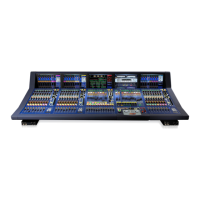276 Chapter 16: Application Notes
XL8 Control Centre
Operator Manual
XL8 EQ modes
This section aims to provide an understanding of the EQ modes contained within the
XL8 control centre.
Basic specification
The XL8 input EQ comprises four bands: treble; hi mid; lo mid; and bass. The default
operation for all four sections is full parametric, with the following controls:
• Gain: continuous adjustment of boost and cut from + 16dB to - 16dB with a 0dB
centre detent.
• Width: continuous adjustment of bandwidth from 0.1 to 3 octaves (this only
operates in bell mode for Bass and Treble).
• Treble: continuous adjustment of the frequency range that the treble equaliser acts
on from 1K to 25K.
• Hi mid and lo mid: hi mid frequency control gives continuous adjustment of the
frequency range that the hi mid equaliser acts on from 320Hz to 8K. Lo mid
frequency control gives continuous adjustment of the frequency range that the lo
mid equaliser acts on from 80Hz to 2K.
• Bass: continuous adjustment of the frequency range that the bass equaliser acts on
from 16Hz to 400Hz.
The treble EQ band can be switched from bell to three other shelving modes: Soft;
Classic; and Bright
The bass EQ band can be switched from bell to three other shelving modes: Warm;
Classic; and Deep
Description
The difference between the shelf filters is subtle and, if you do not have time to
experiment, it is probably best to use classic because this is the best all round filter.
However when you do have time to experiment you may find the other types each have
their uses. The minimum harmonic types, and in particular the bass, can sound very
natural, even with very aggressive EQ, but the psycho-acoustic principles that they
operate on do not always work so well on multiple source or pre-mixed material.
Soft treble
The soft treble response provides a very gentle gradient between EQ’d and non-EQ’d
frequency areas. This produces the absolute minimum of phase shift but does not
provide much differentiation, thus frequencies outside the area of interest are often
unintentionally EQ’d. This is best used to provide gentle shaping of pre-mixed material.
Classic treble
The classic treble response provides a much steeper gradient between EQ’d and
non-EQ’d frequency areas, as made famous by previous Midas consoles like the XL4.
This provides better differentiation and minimal phase shift, but there is some
undershoot error, that is, when boosting the treble, the mids are slightly cut and vice
versa. This is the best all round EQ and especially effective when microphones are
covering multiple sources.

